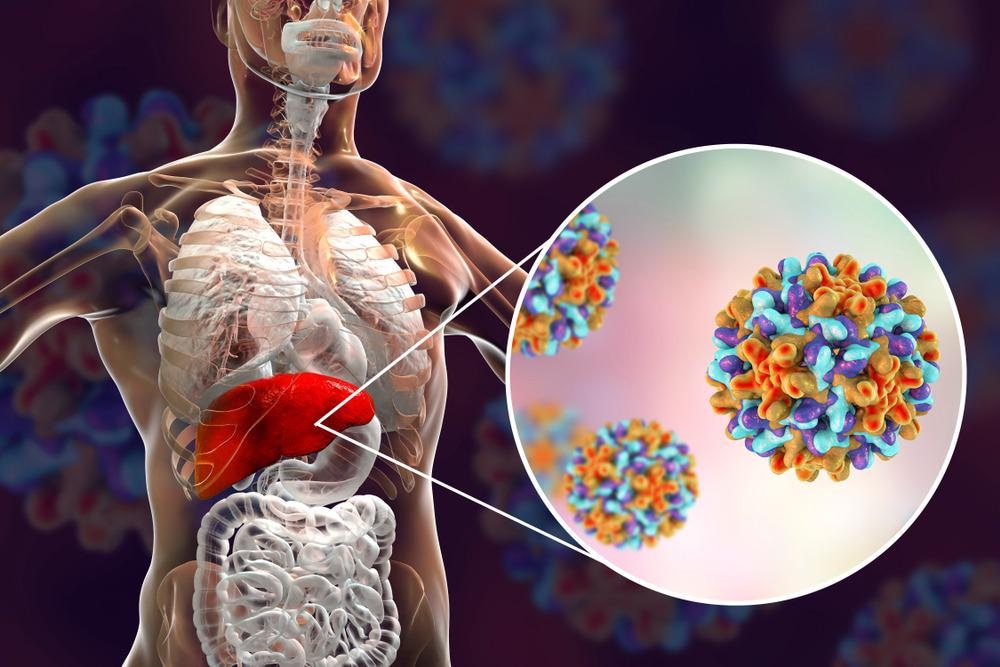Novel nanotechnology research utilizing MXenes for the detection of hepatitis B virus (HBV) has been published in the Journal of Colloid and Interface Science. This innovative research aimed to develop a colorimetric biosensor using probe DNA to advance HBV management.

Study: CRISPR-Cas12a-regulated DNA adsorption and metallization on MXenes as enhanced enzyme mimics for sensitive colorimetric detection of hepatitis B virus DNA. Image Credit: Kateryna Kon/Shutterstock.com
MXenes
MXenes are a type of inorganic compound, which can be described as two-dimension transition metal carbides, nitrides and carbonitrides. These were first introduced in 2011 and include the combination of metallic conductivity of transition metal carbides as well as hydrophilicity.
These nanomaterials have a graphene-like structure, constructed by exfoliating MAX phases, novel structural and functional ceramics with a layered structure; they also have a highly accessible hydrophilic surface compared to graphene and possess a large specific surface area, tunable lateral size, and high electrical conductivity and mechanical robustness.
The desirable properties of MXenes make this innovative nanomaterial versatile for various applications such as, photocatalysts, supercapacitors, antibacterial agents as well as biosensors that use probe DNA.
The development of a biosensor with the use of MXene would allow for the detection of various viruses such as hepatitis B virus and this can be significant for advancing disease diagnosis and the field of medicine.
The Challenges of MXene: Developing a Biosensor
While titanium carbide (Ti3C2) MXenes have been previously shown to have peroxidase-like activity, its catalytic performance is still less effective than nanozymes including metal and metal oxides.
To address this challenging aspect of increasing the catalytic performance of MXenes, researchers have previously involved the combination of MXenes with other nanomaterials, such as nickel and iron layered double hydroxide or copper sulfide nanoparticles, which would generate MXene nanohybrids.
This enhancement of MXene catalytic performance can still be challenging to develop with a simple approach; however, the use of noble metals nanomaterials has gained popularity for this application, with also DNA metallization and using DNA for guiding metal nanofabrication.
Single-stranded template DNA can be effectively adsorbed on Ti3C2Tx MXenes through the use of chelation of phosphate groups within the DNA, with titanium ions on MXenes used for subsequent metallization reactions.
DNA metallization on MXenes can efficiently generate MXene-metal nanohybrids as effective enzyme mimetics for sensitive colorimetric detection.
To this end, researchers from this study investigated the use of probe DNA to increase the catalytic behavior of silver-palladium (Ag/Pt) nanoparticles modified-Ti3C2Tx MXene nanostructures to produce CRISPR-Cas12a based colorimetric biosensors for detecting HBV DNA.
The probe DNA can be used as a template for the synthesis of bimetallic Ag/Pt nanoparticles, as well as acting as an enhancer for increasing MXene catalytic activity. This research resulted in producing a high-performing MXene-probe DNA-Ag/Pt nanohybrids with high peroxidase-mimetic activity.
How Does It Work?
This system works through the Cas12a enzyme that can be activated by the DNA probes when in the presence of HBV targets; this causes inhibition of the DNA metallization and enzyme enhancer DNA adsorbed on MXene, resulting in minimal catalytic activity.
The CRISPR-Cas12a enzyme and a colorimetric amplification nanoplatform based on Mxene-probe DNA-Ag/Pt nanohybrids can produce the first and second signal amplification, respectively. This ultimately provides a novel method for naked-eye accurate and sensitive analysis of HBV DNA without requiring target DNA amplification processes.
Additionally, this nanotechnology-based colorimetric biosensor enables a sensitive visible smartphone-enabled detection of HBV DNA, holding great potential for out-of-laboratory bioassay in remote areas.
Translational Significance
The use of this innovative dual-amplified colorimetric nanoprobe has progressed both nanotechnology and biomedical research with naked-eye inspection of hepatitis B virus targets that have high sensitivity. Additionally, the ability to be able to use this sensing method within a smartphone could revolutionize the concept of biosensors, as this could enable diagnosis in remote areas.
This application could especially be useful in rural areas and countries where access to extensive laboratory equipment can be challenging.
Accurate and sensitive diagnosis of HBV in countries where this disease is widely found can help to increase diagnosis rates which can guide treatments from an earlier stage to prevent this further evolving into hepatitis diseases such as chronic hepatitis or liver cirrhosis.
The future of this research and technology can also be translated for the diagnostics of other diseases, and this would also aid with decreasing the health crisis within global countries.
Reference
Tao, Y., Yi, K., Wang, H., Kim, H., Li, K., Zhu, X. and Li, M., (2022) CRISPR-Cas12a-regulated DNA adsorption and metallization on MXenes as enhanced enzyme mimics for sensitive colorimetric detection of hepatitis B virus DNA. Journal of Colloid and Interface Science, 613, pp.406-414. Available at: https://www.sciencedirect.com/science/article/pii/S0021979722000406?via%3Dihub
Further Reading
Rongjun Yu, Jian Xue, Yang Wang et al. Novel Ti3C2Tx MXene Nanozyme with Manageable Catalytic Activity and Application to Electrochemical Biosensor, 15 February 2022, PREPRINT Available at: https://doi.org/10.21203/rs.3.rs-965061/v2
Disclaimer: The views expressed here are those of the author expressed in their private capacity and do not necessarily represent the views of AZoM.com Limited T/A AZoNetwork the owner and operator of this website. This disclaimer forms part of the Terms and conditions of use of this website.